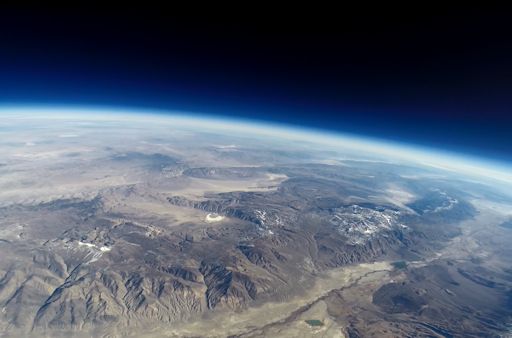OLD SUNSPOT SET TO RETURN: The southeastern limb of the sun is crackling with C- and M-class solar flares. These explosions herald the return of old sunspot AR1944, which produced many strong flares earlier this month. For the past two weeks AR1944 has been transiting the farside of the sun. An uptick in solar activity is possible as it returns to the Earthside this week. Solar flare alerts: text, voice
SPACE WEATHER BALLOON, LAUNCHED AND RECOVERED: Yesterday, the students of Earth to Sky Calculus launched a suborbital helium balloon from Bishop, California, and recovered the payload hours later from a nearby canyon. The goal of the mission was to measure high-energy radiation levels in the stratosphere. Those data are being reduced now. The students also captured panoramic images of California's epic drought:
So much for the Golden State. The landscape of California is remarkably brown as the driest winter in more than a century unfolds. The drought is so bad that the city of Bishop, where the students go to school, looks like a settlement on the planet Mars: image.
"Up and down California, from Oregon to Mexico, it's dry as a bone," comments JPL climatologst Bill Patzert. "To make matters worse, the snowpack in the water-storing Sierras is less than 20% of normal for this time of the year."
Indeed, the towering Sierras, only sparsely covered by crusty month-old snow, lack their usual white reflectance in many of the group's edge of space photos. Not much water will be flowing from those peaks to urban areas when the snow melts in spring. Water rationing and wildfires are likely this summer.
On the bright side, launching the balloon was lots of fun! Stay tuned for updates as the radiation data are analyzed.
Realtime Space Weather Photo Gallery
BRIGHT, NEARBY SUPERNOVA: Approximately 12 million years ago, a white dwarf star in galaxy M82 exploded. A few days ago, light from the supernova finally reached Earth. Amateur astronomers can see it through backyard telescopes as a fireball of magnitude +11. Indeed, it is so bright that small telescopes can be used to study the specturm of the blast. David Strange sends these data from Branscombe, East Devon, UK:
"I used a 9-inch Celestron telescope and a Star Analyzer 100 to record the supernova's colors," says Strange.
His data show a strong absorption line corresponding to ionized silicon. Silicon is one of the products of fusing carbon and oxygen, and a telltale sign that this is a Type 1a supernova explosion. Type 1a supernovas are famous in part because they led to the discovery of Dark Energy in the universe. (And, yes, we know that "Dark Energy" is shorthand for "we don't know what's going on.")
Although it is 12 million light years away, M82 is considered to be a next-door neighbor of the Milky Way. Indeed, this is the nearest supernova to Earth since SN 1993J was observed 21 years ago. The relative proximity of the blast makes it an attractive target for astronomers to study. Light curves from previous Type 1a supernovas suggest that the fireball could continue to brighten for the next two weeks. If you have a GOTO telescope, this evening command it to slew to the "cigar galaxy" or "M82," and watch the explosion unfold.

Solar wind
speed: 332.6 km/sec
density: 2.4 protons/cm3
explanation | more data
Updated: Today at 1646 UT
X-ray Solar Flares
6-hr max: C2 1113 UT Jan27
24-hr: M1 0211 UT Jan27
explanation | more data
Updated: Today at: 1600 UT
![]()
Daily Sun: 27 Jan 14
None of the sunspots on the Earth-facing side of the sun are actively flaring. However, two old sunspots, AR1944 and AR1946, which produced big flares three weeks ago, are about to return from their trip around the farside of the sun. Credit: SDO/HMI
![]()
Sunspot number: 109
What is the sunspot number?
Updated 27 Jan 2014
Spotless Days
Current Stretch: 0 days
2014 total: 0 days (0%)
2013 total: 0 days (0%)
2012 total: 0 days (0%)
2011 total: 2 days (<1%)
2010 total: 51 days (14%)
2009 total: 260 days (71%)
Update 27 Jan 2014
The Radio Sun
10.7 cm flux: 138 sfu
explanation | more data
Updated 27 Jan 2014
![]()
Current Auroral Oval:
Switch to: Europe, USA, New Zealand, Antarctica
Credit: NOAA/POES
![]()
Planetary K-index
Now: Kp= 1 quiet
24-hr max: Kp= 1 quiet
explanation | more data
Interplanetary Mag. Field
Btotal: 4.7 nT
Bz: 3.8 nT north
explanation | more data
Updated: Today at 1646 UT
![]()
Coronal Holes: 27 Jan 14
There are no large coronal holes on the Earthside of the sun. Credit: SDO/AIA.





